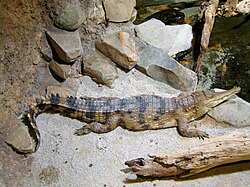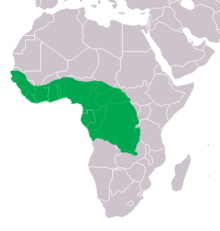Slender-snouted crocodile
| Slender-snouted crocodile Temporal range: Paleocene – Recent |
|
|---|---|
 |
|
| Scientific classification | |
| Kingdom: | Animalia |
| Phylum: | Chordata |
| Class: | Sauropsida |
| Order: | Crocodilia |
| Family: | Crocodylidae |
| Subfamily: | Crocodylinae |
| Genus: | Mecistops Gray, 1844 |
| Species: | M. cataphractus |
| Binomial name | |
|
Mecistops cataphractus (Cuvier, 1825) |
|
 |
|
| Range map | |
| Synonyms | |
|
Crocodylus cataphractus Cuvier, 1825 |
|
Crocodylus cataphractus Cuvier, 1825
The slender-snouted crocodile (Mecistops cataphractus) is a critically endangered species of crocodile from Africa. Traditionally placed in Crocodylus, recent studies in DNA and morphology suggest that it belongs in its own genus, Mecistops.
Slender-snouted crocodiles are native to freshwater habitats in central and western Africa. They are medium-sized crocodiles, typically slightly smaller than the Nile crocodile, but are larger than several other species of crocodilians. Adults are typically about 2.5 m (8.2 ft) long, but have been known to reach 4.2 m (14 ft). They weigh between 125 and 325 kg (276 and 717 lb). They have a slender snout used for catching prey, hence their name.
The diet of the slender-snouted crocodile consists mainly of fish, amphibians and crustaceans. Adults occasionally take smaller mammals, aquatic snakes, turtles and birds. This species is not typically found in groups, except during the onset of the breeding season. The female constructs a mound nest consisting mainly of plant matter. Nests are sited on the banks of rivers, and construction generally begins at the onset of the wet season, although breeding is even within members of one population. It has a similar, but generally shorter nesting season than that of the sympatric dwarf crocodile, which may nest further from the riverine habitat frequented by C. cataphractus.
The slender-snouted crocodile lays an average of 16 (minimum 13, maximum 27) very large eggs (relative to body size) about a week after completion of the mound nest. The incubation period is long compared with most other crocodilian species, sometimes lasting over 110 days. The female remains close to the nest, but does not defend it with the same vigor as some other species of crocodilians. Once the eggs begin to hatch, and the juveniles emit their characteristic chirping, she will break open the nest and assist in the hatching process. Hatchlings then disperse across the flooded forest floor. Although losses from predators do occur (e.g. by soft-shelled turtles), they apparently are minimal, possibly accounting for the small number of relatively large eggs laid, and the long incubation period. They also have very sharp teeth for protection. It is one of four species of crocodile in Africa, the other three being the Nile, desert and dwarf crocodiles.
...
Wikipedia

